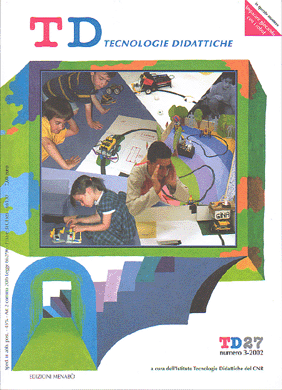Programmable gaming environments for four year olds
Main Article Content
Abstract
Learning to program in kindergarten? Why '? What we can 'be interesting in this for a child? What can 'learn? This article' intended for researchers, designers, educators and parents, they all have good reasons for questioning.
Article Details
Section
Articles - Special Issue

This work is licensed under a Creative Commons Attribution-NonCommercial 4.0 International License.
Authors who publish with this journal agree to the following terms:
- Authors retain copyright and grant the journal right of first publication with the work simultaneously licensed under a Creative Commons Attribution-NonCommercial 4.0 International License.
- Authors are able to enter into separate, additional contractual arrangements for the non-exclusive distribution of the journal's published version of the work (e.g., post it to an institutional repository or publish it in a book), with an acknowledgement of its initial publication in this journal.
- Authors are permitted and encouraged to post their work online (e.g., in institutional repositories or on their website) prior to and during the submission process, as it can lead to productive exchanges, as well as earlier and greater citation of published work (See The Effect of Open Access)
References
Ackermann E. (1991), The “Agency” Model of Transactions: Toward an Understanding of Children’s Theory of Control, in Harel I. & Papert S. (eds), Constructionism, Ablex Publisher, Norwood, NJ.
Ackermann E. (2000), Relating to things that think: Animated toys, artificial creatures, avatars, I3 Magazine: The European Network for Intelligent Information Interfaces, n. 8, July, pp. 2-5.
Ackermann E., Archinto F. (2001), Giochi linguistici, scrittura digitale, alfabetizzazioni emergenti, TD – Tecnologie Didattiche, n. 24, pp. 41-54.
Ackermann E., Strohecker C. (1999), Build, Launch, Convene: Sketches for Constructive-Dialogic Learning Environments, MERL Technical Report, TR99-30.
Ananny M. (2001), Telling Tales: Supporting written literacy with computational toys, Unpublished Master Thesis, The MIT Media Laboratory, Cambridge, MA.
Barchi P., Cagliari P., Giacopini E. (2001), Encounters between children and robotics, in Askildsen T., Barchi P., Cagliari P., Chioccariello A., Giacopini E., Gustafsson B., Lindh J., Manca S., Rausch M., Sarti L., Construction kits made of Atoms and Bits. Research findings & perspectives, CAB Del. 25, http://cab.itd.ge.cnr.it/p ublic/deliverables/booklet/ booklet-CRE.pdf
Brandes A. (1996), Elementary School Children’s Images of Science, in Kafai Y. B., Resnick M. (eds), Constructionism in Practice: Designing, Learning and Thinking in a Digital World, Lawrence Erlbaum Associates, Hillsdale, NJ.
Cassell J., Ryokai K. (2001), Making Space for Voice: Technologies to Support Children’s Fantasy and Storytelling, Personal Technologies, 5(3), pp. 203-224.
Chioccariello A., Manca S., Sarti L. (2002), La fabbrica dei robot, TD Tecnologie Didattiche, n. 27, pp. 56--67.
Granott N. (1991), Puzzled Minds and Weird Creatures: Phases in the Spontaneous Process of Knowledge Construction, in Harel I. & Papert S. (eds), Constructionism, Ablex Publisher, Norwood, NJ, pp. 295-311.
Maeda J. (2000), Design by numbers, The MIT Press, Cambridge, MA.
Martin F. G. (1988), Children, cybernetics, and programmable turtles, Unpublished Master’s thesis, Department of Mechanical Engineering, MIT, Cambridge, MA.
Papert S. (1980), Mindstorms: Children, Computers, and Powerful Ideas, Basic Books, New York.
Papert S. (1993), The Children’s Machine: Rethinking School in the Age of the Computer, Basic Books, New York.
Resnick M., Berg R., Eisenberg M. (2000), Beyond Black Boxes: Bringing Transparency and Aesthetics Back to Scientific Investigation, Journal of the Learning Sciences, vol. 9, n. 1, pp. 7-30 (tr. it. in questo numero).
Turkle S. (1984), The Second Self: Computers and the Human Spirit, Simon and Schuster, New York. Turkle S. (1995), Life on the Screen: Identity in the Age of the Internet, Simon and Schuster, New York.
Ackermann E. (2000), Relating to things that think: Animated toys, artificial creatures, avatars, I3 Magazine: The European Network for Intelligent Information Interfaces, n. 8, July, pp. 2-5.
Ackermann E., Archinto F. (2001), Giochi linguistici, scrittura digitale, alfabetizzazioni emergenti, TD – Tecnologie Didattiche, n. 24, pp. 41-54.
Ackermann E., Strohecker C. (1999), Build, Launch, Convene: Sketches for Constructive-Dialogic Learning Environments, MERL Technical Report, TR99-30.
Ananny M. (2001), Telling Tales: Supporting written literacy with computational toys, Unpublished Master Thesis, The MIT Media Laboratory, Cambridge, MA.
Barchi P., Cagliari P., Giacopini E. (2001), Encounters between children and robotics, in Askildsen T., Barchi P., Cagliari P., Chioccariello A., Giacopini E., Gustafsson B., Lindh J., Manca S., Rausch M., Sarti L., Construction kits made of Atoms and Bits. Research findings & perspectives, CAB Del. 25, http://cab.itd.ge.cnr.it/p ublic/deliverables/booklet/ booklet-CRE.pdf
Brandes A. (1996), Elementary School Children’s Images of Science, in Kafai Y. B., Resnick M. (eds), Constructionism in Practice: Designing, Learning and Thinking in a Digital World, Lawrence Erlbaum Associates, Hillsdale, NJ.
Cassell J., Ryokai K. (2001), Making Space for Voice: Technologies to Support Children’s Fantasy and Storytelling, Personal Technologies, 5(3), pp. 203-224.
Chioccariello A., Manca S., Sarti L. (2002), La fabbrica dei robot, TD Tecnologie Didattiche, n. 27, pp. 56--67.
Granott N. (1991), Puzzled Minds and Weird Creatures: Phases in the Spontaneous Process of Knowledge Construction, in Harel I. & Papert S. (eds), Constructionism, Ablex Publisher, Norwood, NJ, pp. 295-311.
Maeda J. (2000), Design by numbers, The MIT Press, Cambridge, MA.
Martin F. G. (1988), Children, cybernetics, and programmable turtles, Unpublished Master’s thesis, Department of Mechanical Engineering, MIT, Cambridge, MA.
Papert S. (1980), Mindstorms: Children, Computers, and Powerful Ideas, Basic Books, New York.
Papert S. (1993), The Children’s Machine: Rethinking School in the Age of the Computer, Basic Books, New York.
Resnick M., Berg R., Eisenberg M. (2000), Beyond Black Boxes: Bringing Transparency and Aesthetics Back to Scientific Investigation, Journal of the Learning Sciences, vol. 9, n. 1, pp. 7-30 (tr. it. in questo numero).
Turkle S. (1984), The Second Self: Computers and the Human Spirit, Simon and Schuster, New York. Turkle S. (1995), Life on the Screen: Identity in the Age of the Internet, Simon and Schuster, New York.

